Abstract
This study investigated the effects of applied voltage on methane fermentation using separate reactors for the anode and cathode, with activated carbon felt as electrodes and a constant voltage of 0.7 V. Compared to the control, the cathode reactor exhibited approximately 1.2 times higher methane production and 1.3 times higher methane concentration, whereas the anode reactor showed a reduction to about 0.5 times and 0.8 times, respectively. Microbial analysis revealed that the anode reactor created an electron-accepting environment, promoting the growth of Clostridium sensu stricto 1 and Fastidiosipila, both contributing to organic acid (electron) production. Conversely, the cathode reactor established an electron-donating environment, enhancing methane production by hydrogenotrophic methanogens such as Methanoculleus and Methanobacterium. Although similar methanogen levels were found in the anode reactor, methane production was higher in the cathode reactor. These findings indicate that the anode facilitates organic acid production via electron acceptance, while the cathode acts as an electron donor that promotes hydrogenotrophic methanogenesis. This study provides a clear evaluation of the effects of microbial electrochemical technologies on methane fermentation, demonstrating their potential to stimulate microbial activities and enhance methane production.
1. Introduction
The adoption of renewable energy technologies is essential for reducing greenhouse gas emissions. Recently, anaerobic digestion (AD) has garnered considerable attention for its potential in renewable energy applications. This technology produces methane-containing biogas from organic waste, thereby offering the dual benefits of waste treatment and renewable energy generation. However, because anaerobic digestion is a microbiological process, its efficiency is highly susceptible to fluctuations in various factors, such as the quantity and quality of the input biomass (substrate), as well as fermentation parameters such as temperature and agitation.
Electron transfer between microorganisms is believed to be vital for addressing these challenges in anaerobic digestion [1]. Electron transfer between the bacteria that degrade organic matter and the archaea that produce biogas is especially important. This electron transfer between bacteria and archaea is thought to occur via intermediates such as hydrogen or formate via processes known as interspecies hydrogen transfer (IHT) and interspecies formate transfer (IFT), respectively [2]. However, these electron transfer mechanisms are rate-limiting steps in anaerobic digestion. To overcome the limitations of electron transfer, the addition of conductive materials, such as granular activated carbon, has been explored [3]. Conductive materials act as “electron conduits,” physically bridging electron-donating and electron-accepting microorganisms, thereby enabling direct electron transfer across their conductive surfaces. In some cases, conductive materials can substitute for biologically derived conductive structures such as e-pili or outer-membrane c-type cytochromes, facilitating direct interspecies electron transfer (DIET) even in microorganisms that lack these native electron transfer appendages. By lowering the activation barrier for interspecies electron exchange, conductive materials can enhance syntrophic metabolism and stabilize the performance of AD, even under conditions where hydrogen- or formate-mediated electron transfer is inefficient [4]. It has also been reported that when bacteria and archaea form aggregates on the surface of conductive materials, direct electron transfer can occur between the respective microorganisms via structures such as pili, and this mechanism is also referred to as DIET [5]. DIET enhances methane production [6], promotes degradation of volatile fatty acids (VFAs) [7], and increases the rate of substrate degradation [8]. DIET is considered to be faster than IHT and IFT [9]. In recent years, research has been conducted to accelerate DIET by applying an external voltage. This approach involves introducing electrodes into the digester and applying a low-voltage electric field to facilitate electron transfer between the anode and cathode through an external circuit. This technique is known as microbial electrochemical technology (MET) or microbial electrolysis cells–anaerobic digestion (MEC-AD) [10].
In MET, the bacteria responsible for organic matter degradation predominantly colonize the anode, while the methanogenic archaea responsible for biogas production dominate at the cathode [11]. In particular, hydrogenotrophic methanogens, which convert hydrogen and carbon dioxide into methane and water, have been found to be dominant at the cathode [12], making MET an attractive approach for biomethanation. Similar to DIET using conductive materials, MET has been reported to enhance methane production [13], shorten the startup period for fermentation [14], and accelerate substrate degradation [15]. However, because MET is based on the reverse application of microbial fuel cell (MFC) technology, many studies have focused on microbial behavior, while others have investigated fermentation performance [16]. Moreover, the mechanisms by which electrons are transferred from the cathode to the hydrogenotrophic methanogens remain poorly understood. In other research fields, the application of an external voltage has been reported to influence ion channels on microbial cell membranes, potentially affecting metabolic activity [17]. Therefore, MET also may stimulate microbial metabolism during anaerobic digestion. Nonetheless, the mechanisms by which MET affects the efficiency of methane fermentation remain largely unclear. In this study, we evaluated the effects of MET on methane fermentation efficiency by monitoring parameters such as methane concentration and methane production volume. Additionally, we analyzed the microbial community structures in the biofilms formed on the anode and cathode electrodes. Although previous studies have examined electrode-associated microbial communities, most have relied on qualitative assessments based solely on relative abundance. However, because microbial species differ in their rRNA gene copy numbers, relative abundance does not necessarily correlate with actual cell counts. Thus, a quantitative analysis that considers absolute microbial abundance is crucial for accurately assessing the effects of MET on microbial communities. Furthermore, most previous studies introduced both the anode and cathode into the same fermentation reactor. Although some experiments have employed systems separated by ion-exchange membranes, no studies have evaluated MET in which the anode and cathode are placed in separate anaerobic digesters. According to the principles of MET, electron transfer via an external circuit should still occur even if the anode and cathode are housed in separate reactors. Therefore, in this study, we investigated the effects of MET on methane fermentation when introducing the anode and cathode into separate digesters.
2. Materials and Methods
2.1. Experimental Conditions
In this study, inoculum sludge was obtained from a digestion reactor acclimated under the following conditions: a hydraulic retention time (HRT) of 30 days and an organic loading rate of 1 g of volatile solids per liter per day (g-VS/L/day), with swine manure as the substrate. The manure was sourced from small- to medium-scale pig farms in Toyohashi City, Aichi Prefecture, Japan. Anaerobic digestion tests were conducted in 250 mL screw-cap bottles. Each bottle was loaded with 70 mL of inoculum sludge (5 g-VS/L), 10 g of swine manure substrate (2.5 g-VS/g), 10 mL of a reducing agent consisting of a 25 g/L Na2S·9H2O aqueous solution, 70 mL of inorganic salt medium (Table 1), and 33 mL of phosphate buffer solution (Table 2). Three experimental conditions were established: An anode reactor, in which only the anode electrode was introduced; a cathode reactor, in which only the cathode electrode was introduced; and a control reactor, in which no electrodes were introduced to simulate conventional anaerobic digestion. A constant voltage of 0.7 V (direct current; DC) was applied between the anode and cathode electrodes in the anode and cathode reactors using an external power supply. All bottles were placed on magnetic hot stirrers, and batch-type anaerobic digestion was performed under mesophilic conditions at 37 °C with continuous stirring at 100 rpm.

Table 1.
Composition of inorganic salt medium.

Table 2.
Composition of phosphate buffer solution.
2.2. Experimental Setup
The schematic diagram of the experimental setup is shown in Figure 1. The electrodes used for the voltage application were made of activated carbon fiber felt (Shibata Scientific Technology Ltd., Tokyo, Japan) with dimensions of 40 mm (length) × 10 mm (width) × 2 mm (thickness). Each electrode was attached using an alligator clip. The electrodes were connected to a DC-regulated power supply (A&D Co., Ltd., Tokyo, Japan) via vinyl-insulated electrical wires. The power supply was operated in constant voltage (CV) mode, and a continuous DC voltage was applied throughout the fermentation period. During the fermentation, the activated carbon fiber felt electrodes were fixed in position to ensure that they remained fully submerged in the liquid phase at all times.
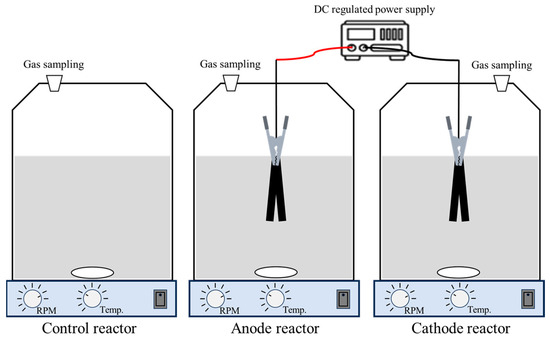
Figure 1.
Schematic diagram of the experimental setup.
2.3. Analysis
During the fermentation period, the biogas generated within the screw-cap bottles created positive pressure. To collect the biogas, a 50 mL syringe was inserted into each bottle, and the volume of biogas was determined based on the syringe scale reading. The methane concentration was measured by sampling biogas (0.5 mL) using a syringe equipped with a stopcock. The analysis was performed using a gas chromatograph (GC-2014, Shimadzu, Kyoto, Japan). A packed column (SHINCARBON ST 50/80, Shinwa Chemical Industries Ltd., Kyoto, Japan) was used with argon (G1) as the carrier gas. A thermal conductivity detector (TCD) was also used. Calibration curves were generated using high-purity methane (99.9%) and carbon dioxide (99.9%) obtained from GL Sciences, Inc. The concentrations of methane and carbon dioxide in the sampled gas were calculated based on the peak areas and corresponding calibration curves. Cumulative methane production was calculated by multiplying the methane concentration by the total volume of biogas produced.
After the fermentation tests, samples were collected by opening the screw-cap of the fermentation bottles. The organic acid concentrations in the liquid phase were determined using a high-performance liquid chromatography system (Shimadzu Corporation, Kyoto, Japan) equipped with a system controller (SCL-10A VP, Shimadzu, Kyoto, Japan), degasser (DGU-14A, Shimadzu, Kyoto, Japan), pump (LC-10AD VP, Shimadzu, Kyoto, Japan), autosampler (SIL-10AD VP, Shimadzu, Kyoto, Japan), column oven (CTO-10AC VP, Shimadzu, Kyoto, Japan), and conductivity detector (CDD-10A VP, Shimadzu, Kyoto, Japan). Separation was performed using a Shim-pack SCR-102H column (Shinwa Kako Corporation, Kyoto, Japan) with 5 mM p-toluenesulfonic acid solution as the mobile phase. For microbial community structure analysis, 1.0 mL of each sample was transferred into a 2.0 mL microtube and subsequently stored at −60 °C. The methodology used to analyze the microbial community is illustrated in Figure 2. Microbial DNA was extracted using the FastDNA SPIN Kit for Soil (MP Biomedicals, Santa Ana, CA, USA). The V4 region of the 16S rRNA gene was amplified by PCR using the primers 515F (5′-GTGYCAGCMGCCGCGGTAA-3′) and 806R (5′-GGACTACNVGGGTWTCTAAT-3′), and sequencing was performed on the MiSeq platform (Illumina, San Diego, CA, USA). The sequencing data were processed using QIIMM2. To quantitatively analyze the microbial community, quantitative PCR (qPCR) was conducted using the primers described above and a real-time thermal cycler (TP1010, Takara Bio Inc., Shiga, Japan). The number of microbial cells present in the sludge was estimated by integrating the next-generation sequencing (NGS) results and qPCR data and comparing it with a 16S rRNA gene copy number database (rrnDB).
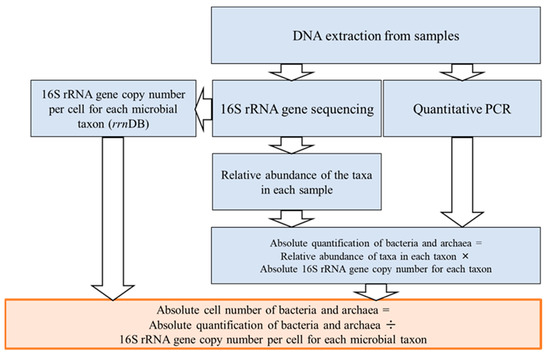
Figure 2.
Method used to analyze the microbial community structure [18].
3. Results and Discussion
3.1. Changes in Methane Production in Each Reactor
The cumulative methane production per gram of volatile solids (VSs) in each experimental reactor is shown in Figure 3. In the cathode reactor, methane production increased sharply after day 7, reaching approximately 210 mL/g-VS by day 30, with a methane concentration of 80%. In the control reactor, methane production increased gradually from day 0, reaching approximately 170 mL/g-VS on day 30, with a methane concentration of 64%. In the anode reactor, methane production began to increase after day 10, reaching approximately 80 mL/g-VS by day 30, with a methane concentration of 50%. The methane production and concentration were higher in the cathode reactor than in the control and anode reactors, which was likely due to enhanced methanogenesis by the hydrogenotrophic methanogens. This result is consistent with the findings of Zhao et al., who reported that hydrogenotrophic methanogens became dominant at the cathode, which enhanced methane production [19]. It is well established that hydrogenotrophic methanogens require not only electrons but also protons and carbon dioxide to produce methane. Traditionally, it has been assumed that in MET systems, protons and carbon dioxide are generated by the microbial degradation of organic matter at the anode and subsequently diffuse through the liquid phase between the electrodes, enabling hydrogenotrophic methanogens at the cathode to carry out methanogenesis. However, the findings of this study demonstrated that even in a methane fermentation reactor equipped solely with a cathode, the protons and carbon dioxide generated by the microorganisms present on the cathode surface alone were sufficient to support methane production by hydrogenotrophic methanogens.
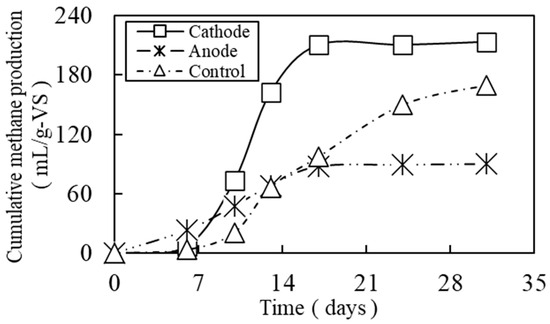
Figure 3.
Cumulative methane production in mL per g of volatile solids (VSs) in each reactor.
The lower methane production and concentration in the anode reactor (compared to the control reactor) may be attributed to two possible factors. First, in the anode reactor, establishment of an environment favoring electron donation to the electrode may have led to a shortage of available electrons for methanogens, thereby hindering methane production. Second, competition may have occurred between electron-producing bacteria and methanogens for acetate. Electrochemically active bacteria (EAB) are known to possess electrical activity. Sun et al. reported that at the anode, certain bacteria utilize electrons from acetate, leading to competition with acetolactic methanogens [20]. This competition ultimately reduces the acetate available for methane production. A similar mechanism likely occurred in the anode reactor in this study, resulting in a lower methane concentration (50%) and reduced methane production than in the control reactor.
Traditionally, the effects of MET on methane fermentation have been evaluated by introducing both an anode and cathode into a single reactor. However, the present study enabled a clear assessment of the individual effects of each electrode on methane fermentation and revealed that it is the cathode that exerts a beneficial influence on the methanogenesis process. Moreover, the phenomena observed in both the anode and cathode reactors were consistent with findings reported in previous studies, suggesting that electron transfer between electrodes occurred via an external circuit in the MET system. These results imply that the potential difference generated between the electrodes may have led to the proliferation of microorganisms that were activated by donating electrons to the anode and microorganisms that were activated by receiving electrons from the cathode. Although we can assume that the electrical circuit was incomplete because of the physical separation of the anode and cathode, the findings of this study provide evidence that electrons were indeed transferred between the electrodes. This is the first demonstration that the effects of MET on methane fermentation are independent of the distance between electrodes.
3.2. Bacteria Abundance at the Genus Level in Each Reactor
The number of bacteria at the genus level in each experimental reactor is shown in Figure 4. In this figure, the top 30 bacterial genera are presented in descending order based on their absolute abundance. Genera ranked below 31st each accounted for no more than 0.74% of the total bacterial count, suggesting that their impact on the overall results of this study is likely minimal. These lower-abundance genera (31st and below) were grouped as “Others,” and their relative abundances were calculated as 9.15% in the control reactor, 10.71% in the anode reactor, and 11.75% in the cathode reactor. When comparing the total bacterial counts across the experimental reactors, the anode reactor exhibited the highest bacterial density, with approximately five times more bacterial cells per milliliter of sludge than the control reactor and approximately twice as many as the cathode reactor. Zhang et al. reported that bacteria involved in methane fermentation were more abundant at the anode [21]. In the present study, quantitative analysis revealed that the anode reactor contained the highest number of bacterial cells. Both Clostridium sensu stricto 1 and Fastidiosipila, whose absolute microbial abundance increased in the anode and cathode reactors compared to the control, belong to the phylum Firmicutes and have been reported to play significant roles in substrate hydrolysis and organic acid production during methane fermentation [22,23]. The organic acid concentrations measured in each reactor are shown in Figure 5. The organic acid concentration after the fermentation was highest in the anode reactor, followed by the cathode reactor, and lowest in the control reactor. This further suggests that the acid-producing bacteria Clostridium sensu stricto 1 and Fastidiosipila played a predominant role.
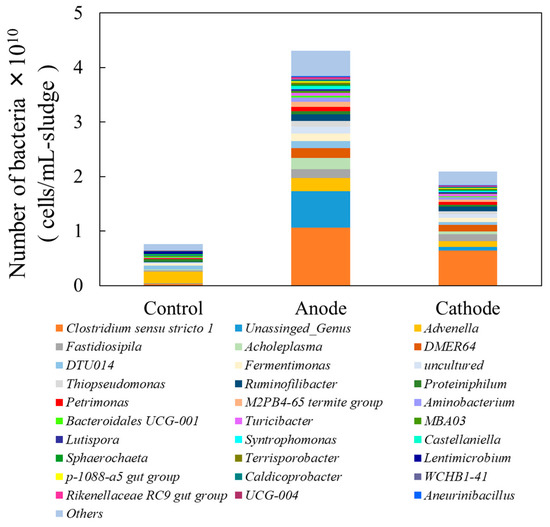
Figure 4.
Number of bacteria at the genus level in each reactor.
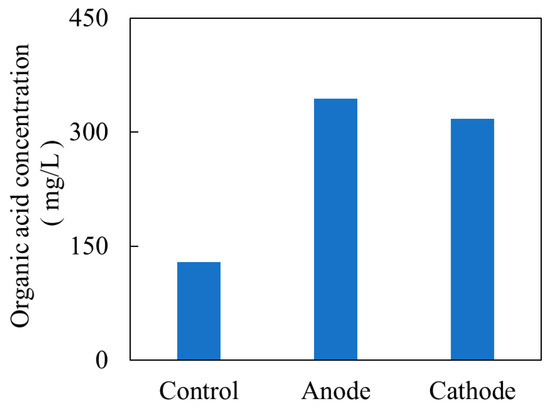
Figure 5.
Organic acid concentration in each reactor.
The conversion of substrates into organic acids involves the oxidation of electron-rich compounds and thus inevitably results in the release of electrons. For example, the oxidation of glucose to acetate releases eight moles of electrons per mole of glucose, which are transferred to intracellular electron carriers such as NADH, FADH2, or reduced ferredoxin [24]. These electrons are subsequently transferred to extracellular electron acceptors either indirectly via electron carriers such as hydrogen or formate, or directly via outer-membrane c-type cytochromes and conductive pili [4]. Therefore, the observed increases in Clostridium sensu stricto 1 and Fastidiosipila in both the anode and cathode reactors, along with the elevated organic acid concentrations, suggest that these taxa may have contributed to DIET through electron release associated with organic acid production, thereby strengthening syntrophic interactions with hydrogenotrophic methanogens. Similarly, the increased absolute microbial abundance of DMER64 in the anode and cathode reactors, which has been reported to be involved in DIET, further supports this observation [25]. These findings indicate that the anode and cathode reactors contained a greater number of organic acids producing bacteria than the control reactor, promoting electron releasing reactions associated with organic acid production and enhancing DIET processes. According to the reported principles of MET, the cathode environment where electrons are supplied from the electrode is not typically considered beneficial for bacterial activity. However, the greater total bacterial count observed in the cathode reactor compared to the control suggests that the cathode functioned as a physical support for microbial colonization, independent of its role in electron transfer. Moreover, it is likely that protons and carbon dioxide required by hydrogenotrophic methanogens on the cathode for methane production were supplied by other bacteria present on the cathode surface. The anode reactor contained a higher total bacterial count than the cathode reactor, indicating that organic acid production by bacteria was particularly enhanced at the anode. Notably, the absolute microbial abundance of Clostridium sensu stricto 1 in the anode reactor was approximately 32 times higher than in the control reactor. These results suggest that the anode not only served as a carrier for bacterial retention but also effectively accepted electrons released by bacteria.
Based on the above, separate evaluations of the anode and cathode reactors allowed for a detailed assessment of the individual effects of each electrode on the methane fermentation process. To enhance organic acid production during methane fermentation, the presence of an electron accepting component is essential, and the anode in MET systems sufficiently fulfills this role. Even with the introduction of a cathode, the absolute microbial abundance of bacteria and organic acid production were promoted, indicating that, in addition to its function in MET, the activated carbon felt used as the electrode material served as a microbial support, facilitating DIET among microbes residing on the cathode.
3.3. Archaea Abundance at the Genus Level in Each Reactor
The (A) relative abundance and (B) absolute microbial abundance of archaea at the genus level in each experimental reactor are shown in Figure 6. Zhu et al. reported that the relative abundance of archaea on the cathode was higher than on the anode, with a particularly high proportion of hydrogenotrophic methanogens, which contributed to enhanced methane production on the cathode [26]. In the present study, the combined relative abundance of the hydrogenotrophic methanogens Methanoculleus [27] and Methanobacterium [28] was approximately 38% in the anode reactor and 71% in the cathode reactor, consistent with previously reported trends, as shown in Figure 6A. However, when focusing on the absolute microbial abundance shown in Figure 6B, the total number of archaea per milliliter of sludge was highest in the anode reactor, being approximately 17 times greater than in the control reactor and about 1.5 times greater than in the cathode reactor. Consequently, the total number of hydrogenotrophic methanogens (Methanoculleus and Methanobacterium) was nearly equivalent between the anode and cathode reactors. This can be attributed to the overall microbial cell count in the anode reactor (1.635 × 1010 cells/mL-sludge) being higher than that in the cathode reactor (1.064 × 1010 cells/mL-sludge). In the case of the control reactor, the relative abundance shown in Figure 6A might suggest a higher proportion of hydrogenotrophic methanogens compared to the anode reactor. However, because the total number of archaea in the control reactor was only about 9.8 × 108 cells/mL-sludge, the absolute microbial abundance shown in Figure 6B clearly indicates that the number of hydrogenotrophic methanogens was substantially lower than in the anode and cathode reactors.
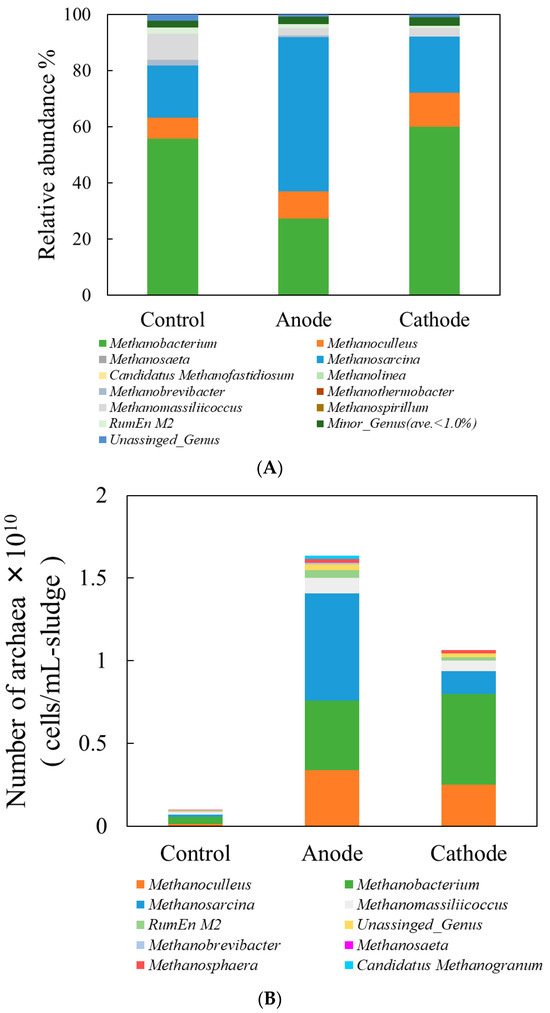
Figure 6.
(A) Relative abundance and (B) absolute microbial abundance of archaea at the genus level in each reactor.
On the other hand, Methanosarcina [29], which is capable of utilizing both acetate and hydrogen, was significantly more abundant in the anode reactor than in the cathode reactor. This may be due to Methanosarcina assimilating the acetate produced by the large number of bacteria present on the anode. Although the total number of archaea was higher in the anode reactor than in the cathode reactor, Figure 2 shows that methane production and methane concentration were both lower in the anode reactor. Two main reasons are considered for this outcome. First, as previously mentioned, there may have been competition for acetate on the anode [20], potentially limiting the ability of Methanosarcina to generate methane. Second, since the anode reactor environment was structured for electron donation to the electrode, hydrogenotrophic methanogens, which require electron uptake, may not have been able to function effectively. Taken together, these findings suggest that although the anode reactor had a higher total number of archaea, methane production was limited, resulting in a methane concentration of around 50%. In contrast, the cathode reactor, despite having fewer archaea overall, exhibited increased methane production and higher methane concentration. This suggests that electron donation from the cathode enhanced the activity of hydrogenotrophic methanogens, thereby promoting methane production.
Therefore, to enhance methane production during anaerobic digestion, it is essential to stimulate methane generation by hydrogenotrophic methanogens, which requires the presence of an electron-donating environment such as that provided by the cathode in MET.
SEM images of the cathode before and after the experiment are shown in Figure 7. Before the experiment, the activated carbon felt exhibited a smooth surface. In contrast, after the experiment, rod-shaped microorganisms were observed adhering to the electrode surface along with accumulated organic matter. Previous studies have reported that smooth carbon fiber surfaces are generally unfavorable for microbial attachment [30]. However, the adhesion of organic matter and microorganisms observed in this study suggests that even carbon felt with a smooth surface can effectively function as a carrier for microbial colonization and organic matter retention. These findings imply that the application of voltage may have altered the surface properties of the electrode, thereby enhancing its capacity to retain both microorganisms and organic matter.
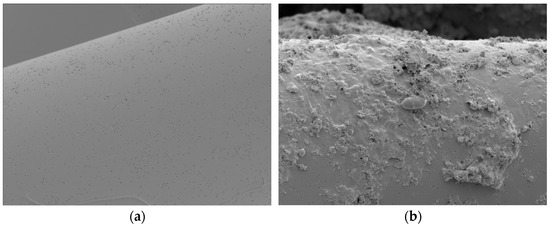
Figure 7.
SEM images (×5000) of the cathode before (a) and after (b) the experiment.
4. Conclusions
In this study, the relationship between individual electrodes and methane fermentation, which has received limited attention to date, was evaluated by introducing anodes and cathodes into separate fermentation reactors. As a result, increased abundances of Clostridium sensu stricto 1 and Fastidiosipila in the anode reactor indicated that organic acid production was more pronounced compared to the other experimental conditions. Furthermore, the anode was found to function not only as a microbial support but also as an effective electron acceptor for electrons released by bacteria. Although the total archaea count in the cathode reactor was lower than that in the anode reactor, hydrogenotrophic methanogens such as Methanoculleus and Methanobacterium were present in comparable numbers. Moreover, the cathode reactor exhibited the highest methane production among all experimental conditions. These results suggest that the cathode supplied electrons transferred from the anode via an external circuit to hydrogenotrophic methanogens on its surface, thereby enhancing methane production. The separation of the anode and cathode reactors in this study was not intended as a direct step toward technological implementation but rather as an experimental strategy to independently evaluate biogas production behavior and microbial community trends at each electrode. This approach allowed for a clearer interpretation of the functional roles of the anode and cathode in MET systems. Overall, the results demonstrate that the anode served as an electron acceptor essential for promoting organic acid production, while the cathode acted as an electron donor that stimulated methane generation by hydrogenotrophic methanogens. Thus, MET has proven to be a promising technology for activating both bacteria and archaea involved in the methane fermentation process.
In this study, since no commercially available lid could accommodate both the electrodes and maintain the airtightness of the fermentation reactors, we fabricated and used custom-made lids. In future applications, particularly for continuous methane fermentation trials or full-scale plants, it will be necessary to explore methods that utilize commercially available components to facilitate easier electrode integration. In the future, it will be necessary to focus on optimizing parameters such as electrode materials and applied voltage to further enhance the performance of MET. Furthermore, while this study employed a batch-type fermentation system, it is essential to verify whether similar effects can be observed in continuous fermentation systems. The findings of this study provide fundamental insights for establishing bio electrochemical systems that can selectively stimulate microbial functions, such as organic acid generation at the anode and hydrogenotrophic methanogenesis at the cathode, to maximize methane yield. This, in turn, has the potential to contribute to improved process stability, higher energy recovery efficiency, and reduced operational costs in renewable energy production at actual biogas plants. Advancing the scientific and engineering understanding of MET will not only contribute to the further development of methane fermentation technologies but also pave the way for the realization of efficient and stable methane fermentation systems.
Author Contributions
Conceptualization, H.K.; methodology and formal analysis, H.K.; investigation and writing—original draft preparation, H.K.; writing—review and editing, H.K. and M.K. and H.D.; supervision, H.D.; funding acquisition, H.D. All authors have read and agreed to the published version of the manuscript.
Funding
This research was funded by JSPS KAKENHI, grant number JP24H00773.
Institutional Review Board Statement
Not applicable.
Informed Consent Statement
Not applicable.
Data Availability Statement
Data are presented within the article.
Acknowledgments
We would like to thank FASMAC Co., Ltd. (Kanagawa, Japan) for their sequencing services and technical support. We also acknowledge Kobelco Eco-Solutions Co., Ltd. (Hyogo, Japan) for their valuable assistance in providing experimental materials and insights related to methane fermentation technologies.
Conflicts of Interest
The authors declare no conflicts of interest.
References
- Su, K.; Li, L.; Wang, Q.; Cao, R. A Review on the Interspecies Electron Transfer of Methane Production in Anaerobic Digestion System. Fermentation 2023, 9, 467. [Google Scholar] [CrossRef]
- Zhang, M.; Zang, L. A review of interspecies electron transfer in anaerobic digestion. Earth Environ. Sci. 2019, 310, 042026. [Google Scholar] [CrossRef]
- Xiao, L.; Liu, J.; Kumar, P.S.; Zhou, M.; Yu, J.; Lichtfouse, E. Enhanced methane production by granular activated carbon: A review. Fuel 2022, 320, 123903. [Google Scholar] [CrossRef]
- Lovley, D.R. Syntrophy Goes Electric: Direct Interspecies Electron Transfer. Annu. Rev. Microbiol. 2017, 71, 643–664. [Google Scholar] [CrossRef]
- Zhou, X.; Guo, M.; Fu, X.; Wang, D.; Liao, J.; Xu, W.; Han, H. Insights into microbial metabolic coordination under driving force of different conductive materials-mediated direct interspecies electron transfer during anaerobic digestion. Chem. Eng. J. 2024, 496, 154230. [Google Scholar] [CrossRef]
- Wang, Z.; Li, Y.; Ao, Z.; Li, Y.; Zhao, Z.; Zhang, Y. Boosting conversion of waste activated sludge to methane during anaerobic digestion via facilitating direct interspecies electron transfer with glycerol. Renew. Energy 2024, 233, 121176. [Google Scholar] [CrossRef]
- He, Y.; Wang, S.; Shen, C.; Wang, Z.; Liu, Y.; Meng, X.; Li, X.; Zhao, X.; Chen, J.; Xu, J.; et al. Biochar accelerates methane production efficiency from Baijiu wastewater: Some Viewpoints considering direct interspecies electron transfer. Chem. Eng. J. 2024, 497, 154527. [Google Scholar] [CrossRef]
- Jiang, W.; He, J.; Yin, S.; Ruan, X.; Zhao, Y.; Liu, Y.; Cui, X.; Liu, Z. Differential effects of GAC and graphite on interspecies electron transfer during anaerobic digestion of waste activated sludge for methane production. J. Environ. Chem. Eng. 2024, 12, 113554. [Google Scholar] [CrossRef]
- Tian, J.; Zhang, X.; Ji, B.; Lu, J. Mechanistic insights into the role of tannic acid on iron-biochar composites in modulating microbial direct interspecies electron transfer toward efficient anaerobic wastewater treatment. Chem. Eng. J. 2025, 511, 161925. [Google Scholar] [CrossRef]
- Wang, X.T.; Zhang, Y.F.; Wang, B.; Wang, S.; Xing, X.; Xu, X.J.; Liu, W.Z.; Ren, N.Q.; Lee, D.J.; Chen, C. Enhancement of methane production from waste activated sludge using hybrid microbial electrolysis cells-anaerobic digestion (MEC-AD) process—A review. Bioresour. Technol. 2022, 346, 126641. [Google Scholar] [CrossRef]
- Li, M.; Jiang, N.; Ye, M.; Wei, Y.; Wang, Y.; Qi, X.; Chen, W.; Meng, F.; Jia, X.; Xi, B. Degradation and methanogenesis performance of propionate and butyrate in an anaerobic digestion and microbial electrolysis cell integrated system. Fuel 2025, 392, 134875. [Google Scholar] [CrossRef]
- Di, Y.; Hou, W.; Bian, C.; Zheng, T.; Xiao, B.; Li, L. Enhancing anaerobic digestion of swine manure using microbial electrolysis cell and microaeration. Chem. Eng. J. 2025, 514, 163319. [Google Scholar] [CrossRef]
- Guo, M.; Guo, M.; Wang, Y.; Li, M.; Qi, X.; Wei, S.; Jia, X. The influencing mechanisms of AD-MEC domesticated sludge to alleviates propionate accumulation and enhances methanogenesis. Bioresour. Technol. 2024, 393, 129996. [Google Scholar] [CrossRef] [PubMed]
- Zhou, L.; Wu, Y.; Zhang, S.; Li, Y.; Gao, Y.; Zhang, W.; Tian, L.; Li, T.; Du, Q.; Sun, S. Recent development in microbial electrochemical technologies: Biofilm formation, regulation, and prevention and control. J. Water Process Eng. 2022, 49, 103135. [Google Scholar] [CrossRef]
- Coromina, H.M.; Cuffaro, G.A.; Tommasi, T.; Puing, S.; Virdis, B. A slurry electrode based on reduced graphene oxide and poly (sodium 4-styrenesulfonate) for applications in microbial electrochemical technologies. J. Electroanal. Chem. 2022, 920, 116546. [Google Scholar] [CrossRef]
- Elsayed, A.; Kakar, F.L.; Abdelrahman, A.M.; Ahmed, N.; AlSayed, A.; Zagloul, M.S.; Muller, C.; Bell, K.Y.; Santoro, D.; Norton, J.; et al. Enhancing anaerobic digestion Efficiency: A comprehensive review on innovative intensification technologies. Energy Convers. Manag. 2024, 320, 118979. [Google Scholar] [CrossRef]
- Zheng, M.; Xu, J.; Xu, X.; Tang, Z.; Hou, Y.; Li, X.; Li, Q.; Li, M.; Wei, D.; Cao, Z. Medium-chain fatty acid production via microbial electrosynthesis: Mechanisms, progress, and prospects. Int. J. Electrochem. Sci. 2025, 20, 101091. [Google Scholar] [CrossRef]
- Jian, C.; Luukkonen, P.; Yki-Järvinen, H.; Salonen, A.; Korpela, K. Quantitative PCR provides a simple and accessible method for quantitative microbiota profiling. PLoS ONE 2020, 15, e0227285. [Google Scholar] [CrossRef]
- Zhao, L.; Wang, X.T.; Chen, K.Y.; Wang, Z.H.; Xu, X.J.; Zhou, X.; Xing, D.F.; Ren, N.Q.; Lee, D.J.; Chen, C. The underlying mechanism of enhanced methane production using microbial electrolysis cell assisted anaerobic digestion (MEC-AD) of proteins. Water Res. 2021, 201, 117325. [Google Scholar] [CrossRef]
- Sun, Y.; Heijne, A.T.; Rijnaarts, H.; Chen, W.S. The effect of anode potential on electrogenesis, methanogenesis and sulfidogenesis in a simulated sewer condition. Water Res. 2022, 226, 119229. [Google Scholar] [CrossRef]
- Zhang, M.; Han, Y.; Zeng, Y.; Wang, T.; Wang, Z.; Wu, Y.; Li, N.; Lobo, F.L.; Wang, X. Understanding the microbial processes on carbon brushes that accelerate methanogenesis of long-chain fatty acids in anaerobic digestion. Water Res. 2025, 273, 123084. [Google Scholar] [CrossRef]
- Greige, S.; Abdallah, M.; Webster, C.F.; Harb, M.; Beyenal, H.; Wazne, M. Microbial community analysis of the biofilms of both working and counter electrodes in single-chamber microbial electrolysis cells. Enzym. Microb. Technol. 2025, 188, 110650. [Google Scholar] [CrossRef]
- Rusanowska, P.; Zieliński, M.; Kisielewska, M.; Dudek, M.; Paukszto, Ł.; Dębowski, M. Methane Production, Microbial Community, and Volatile Fatty Acids Profiling During Anaerobic Digestion Under Different Organic Loading. Energies 2025, 18, 575. [Google Scholar] [CrossRef]
- Schuchmann, K.; Müller, V. Energetics and Application of Heterotrophy in Acetogenic Bacteria. Appl. Environ. Microbiol. 2016, 82, 4056–4069. [Google Scholar] [CrossRef] [PubMed]
- Lee, J.; Koo, T.; Yulisa, A.; Hwang, S. Magnetite as an enhancer in methanogenic degradation of volatile fatty acids under ammonia-stressed condition. J. Environ. Manag. 2019, 241, 418–426. [Google Scholar] [CrossRef] [PubMed]
- Zhu, Y.; Guo, M.; Qi, X.; Li, M.; Guo, M.; Jia, X. Enhanced degradation and methane production of food waste anaerobic digestate using an integrated system of anaerobic digestion and microbial electrolysis cells for long-term operation. Environ. Sci. Pollut. Res. 2024, 31, 39637–39649. [Google Scholar] [CrossRef]
- MiDAS Field Guide: Genus: Methanoculleus. Available online: https://midasfieldguide.org/guide/fieldguide/genus/methanoculleus (accessed on 19 June 2025).
- Fiore, N.A.; Kohtz, A.J.; Miller, D.N.; Antony-Babu, S.; Pan, D.; Lahey, C.; Huang, X.; Lu, Y.; Buan, N.R.; Weber, K.A. Microbial methane production from calcium carbonate at moderately alkaline pH. Commun. Earth Environ. 2025, 6, 85. [Google Scholar] [CrossRef]
- Perez-Esteban, N.; Tully, R.; Peces, M.; Dosta, J.; Astals, S. Consistent acidogenic co-fermentation of waste activated sludge and food waste under thermophilic conditions. Water Res. 2025, 271, 122970. [Google Scholar] [CrossRef]
- Xu, S.; Jiang, Q. Surface modification of carbon fiber support by ferrous oxalate for biofilm wastewater treatment system. Clean. Prod. 2018, 194, 416–424. [Google Scholar] [CrossRef]
Disclaimer/Publisher’s Note: The statements, opinions and data contained in all publications are solely those of the individual author(s) and contributor(s) and not of MDPI and/or the editor(s). MDPI and/or the editor(s) disclaim responsibility for any injury to people or property resulting from any ideas, methods, instructions or products referred to in the content. |
© 2025 by the authors. Licensee MDPI, Basel, Switzerland. This article is an open access article distributed under the terms and conditions of the Creative Commons Attribution (CC BY) license (https://creativecommons.org/licenses/by/4.0/).